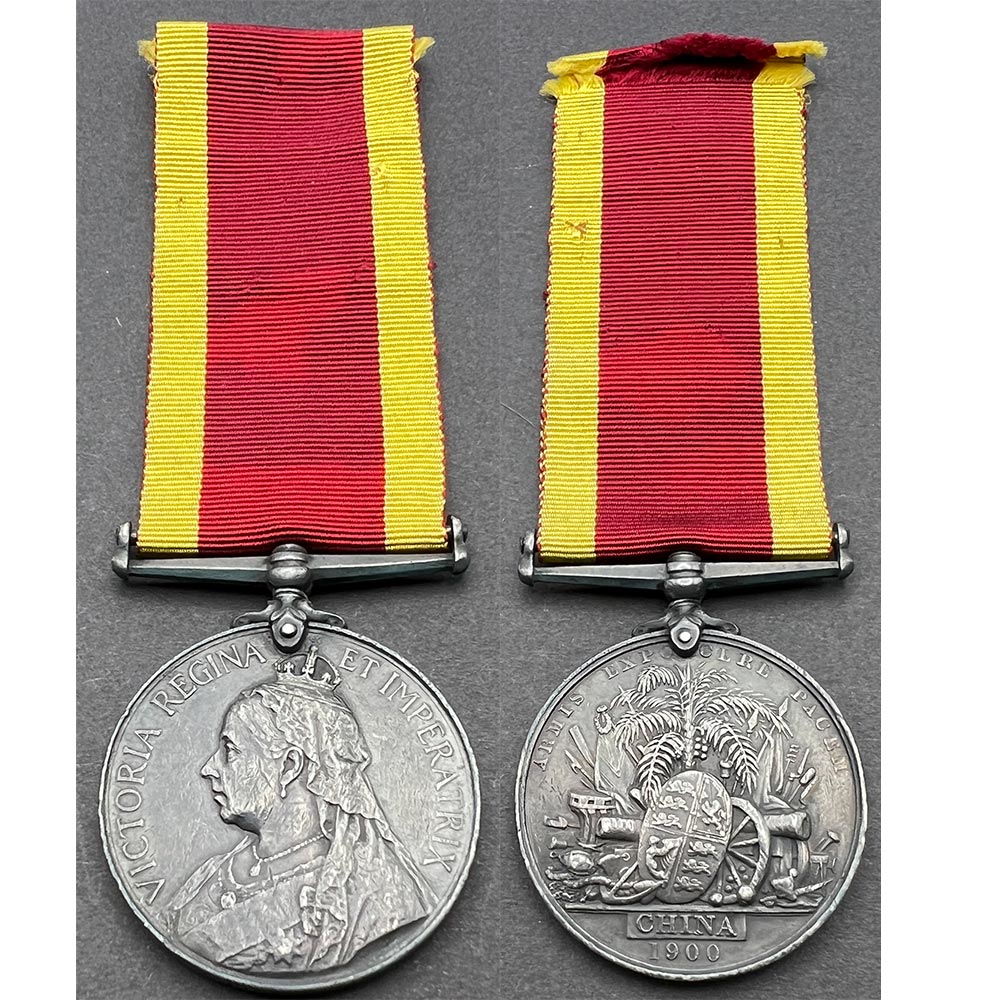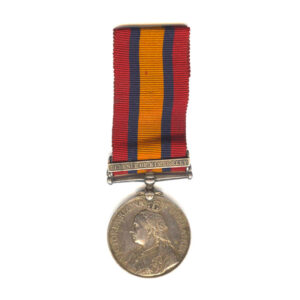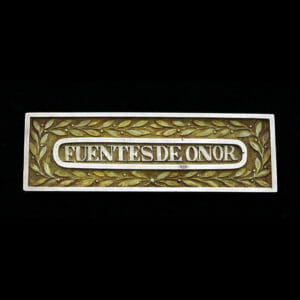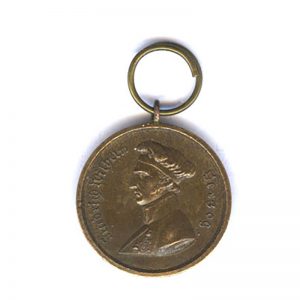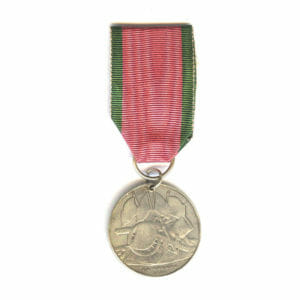Description
China 1900, no bar, William Ernest Bond, Stoker, HMS Bonaventure, served 26 years in the Royal Navy without break.
Officially impressed: “W.G. Bond, Sto., H.M.S. Bonaventure”
Some edge knicks and wear, the recipient having served another 19 years after the war in China.
Dark toned.
Confirmed as correct on the medal roll as “W.G. Bond”, according to his service records he was actually William Ernest Bond, someone having mixed up the G with an E it seems.
Medal notes as issued to him whilst serving at the Wei Hai Wei Naval Depot.
A little unusual as according to his service papers, he never actually served on the Bonaventure, but HMS Centurion, from 15th November 1900 until 30th June 1901, being stationed at the Naval Depot Wei Hai Wei, during this time HMS Glory collided with the Centurion during a storm, he might have been lent from the Depot to Bonaventure.
He would then switch over to HMS Glory from 1st July 1901, receiving 2 promotion, leaving the ship on 26th March 1904.
During this period he would be on the ship for this service:
“While there, she (The Glory) collided with the battleship Centurion during a storm at Hong Kong on 17 April 1901, when Centurion drifted across her bows, but Glory suffered no damage. In June 1901, Vice-Admiral Sir Cyprian Bridge, about to succeed as Commander-in-Chief of the China Station, hoisted his flag on the ship, and Captain Arthur William Carter succeeded Inglefield in command.
Glory refitted at Hong Kong in 1901–1902, and in November 1902 she visited Shanghai.
In April 1903, Glory and the protected cruiser Blenheim joined a naval review held for the Japanese Emperor Meiji in Kobe, Japan. The foreign naval contingent included the Italian protected cruiser Calabria, the German protected cruiser SMS Hansa, the French protected cruiser Pascal, and the Russian protected cruiser Askold.”
Additional note on the naval review:
“In 1903 when Emperor Meiji came to the mountain for Kankanshiki, for a naval review ceremony, elementary school children lined up in the shape of an anchor (ikari) at Kuchiichiri, a triangulation station, on the side of the mountain waving the national flags to welcome the Emperor. Thereafter, the mountain was named ‘Mt. Ikari’ when memorable pine trees were planted on the marks of the anchor. Pine trees were also planted on a mountain next to Mt. Ikari, in shape of Shisho (city symbol).”
Born on 6th November 1874 in Kingsbridge Devon.
First joined the Royal Navy on 11th September 1893 as Stoker 2nd Class at HMS Vivid II.
Promoted to Stoker, HMS Bellona, 4th November 1894.
Promoted, Leading Stoker 2nd Class, HMS Glory, 17th September 1902, China Station.
Promoted, Leading Stoker 1st Class, 1st October 1903, HMS Glory, China Station.
Promoted, Stoker Petty Officer, HMS Devonshire, 1st July 1906
Promoted, Acting Chief Stoker, 14th February 1911, HMS Medea
Promoted, Chief Stoker, HMS Blake, 14th February 1912
He would remain as Chief Stoker until the end of World War 1 in mid 1919.
World War 1 Services, Gallipoli Landings, Surviving a Torpedo.
HMS Dublin, Chief Stoker, 11th March 1913 – 5th Feb 1916
During this time, initially on the outbreak of the War, the ship took part in the Pursuit of Goeben:
“Captain John Kelly pursued the German cruiser Goeben to Messina (off the north coast of Sicily) on 4 August 1914 just prior to the outbreak of the First World War. On 6 August after having completed coaling, Dublin left Malta at 14:00 to join Rear-Admiral Ernest Troubridge’s squadron. At 20:30 she received orders to obtain Goeben’s course and sink her during the night, by torpedoes if possible. Observing at a distance, Kelly expected to engage around 03:30 but Goeben had unexpectedly altered course to the north. The chase was lost as a daylight attack would be suicidal; Goeben’s largest guns could accurately fire explosive shells up to 10 miles (16 km) away.”
They then took part in the Gallipoli Landings before Bond was in the engine rooms as she was torpedoed by the Austro-Hungarian Sub U-4:
“In February 1915, Dublin was sent to the Dardanelles and subsequently assisted Implacable’s landing assault upon Gallipoli, on 25 April 1915 at X Beach. She was then sent to Brindisi in May 1915.
While taking part in a sweep off the Albanian coast, and whilst escorted by French and Italian destroyers, Dublin was hit and damaged by a torpedo from the Austro-Hungarian Navy submarine U-4 on 9 June 1915. Dublin was able to get underway at 17 knots (31 km/h; 20 mph) and to return to Brindisi but was out of action for several months and had to return to the UK for refit.”
HMS Vivid II, Chief Stoker, 6th February 1916 – 31st July 1916, sent here whilst the Dublin was being repaired.
HMS Blake (Romola), meaning he was onboard HMS Romola from 1st August 1916 until 31st January 1919.
Part of the original crew of the newly launched Destroyer HMS Romola, as Chief Stoker.
On commission the ship joined the 11th Destroyer Flotilla with the Grand Fleet. On 24th April 1918 the Flotilla was called to intercept the High Seas Fleet on what was to prove to be the last major expedition by the German Navy during the war. The ships did not managed to meet and no shots were fired in anger.
HMS Vivid, 1st February 1919 – 28th April 1919, when discharged to pension.
